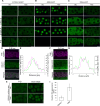The recruitment of the A-type cyclin TAM to stress granules is crucial for meiotic fidelity under heat
- PMID: 40779619
- PMCID: PMC12333678
- DOI: 10.1126/sciadv.adr5694
The recruitment of the A-type cyclin TAM to stress granules is crucial for meiotic fidelity under heat
Abstract
Stress granules (SG) are biomolecular condensates that represent an adaptive response of cells to various stresses, including heat. However, the cell type-specific function and relevance of SG formation, especially during reproductive development, are largely not understood. Here, we show that the meiotic A-type cyclin TARDY ASYNCHRONOUS MEIOSIS (TAM) is recruited to SGs in male meiocytes of Arabidopsis after exposure to heat. We find that the amino terminus of TAM is necessary and sufficient for the localization of proteins to meiotic SGs. Swapping the amino terminus of TAM with the one of its sister protein CYCA1;1 resulted in a separation-of-function allele of TAM, which prevents the partitioning of TAM to SGs while restoring a wild-type phenotype in a tam mutant background under nonheat stress conditions. Notably, plants expressing this TAM version prematurely terminate meiosis under heat resulting in unreduced gametes. Thus, the formation of TAM-containing SGs is necessary for genome stability under heat stress.
Figures






References
-
- De Jaeger-Braet J., Schnittger A., Heating up meiosis—Chromosome recombination and segregation under high temperatures. Curr. Opin. Plant Biol. 80, 102548 (2024). - PubMed
-
- Brownfield L., Kohler C., Unreduced gamete formation in plants: Mechanisms and prospects. J. Exp. Bot. 62, 1659–1668 (2011). - PubMed
MeSH terms
Substances
LinkOut - more resources
Full Text Sources

